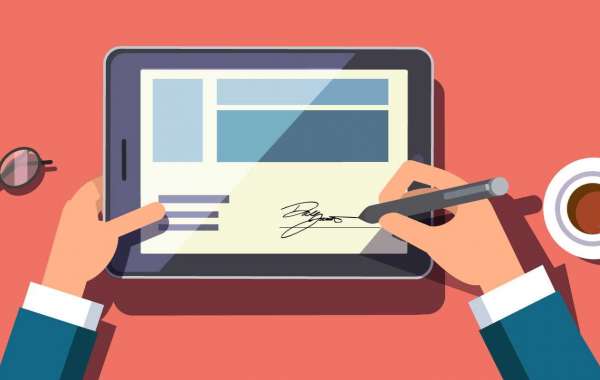Digital signatures have taken the role of traditional signatures due to their simplicity of use, ease of verification, and security.
An individual's name is represented by their traditional or handwritten signatures, which serve as identification proof. Since ancient times, people have been signing all significant papers to attest to their legitimacy.
Signatures have been used to verify the identities on a variety of papers, including contracts, employment applications, and admittance forms.
Years after this practise of electronically signing papers began, digital signatures have taken the role of traditional signatures.
Handwritten signatures online have been phased out in favour of pins, biometrics, chips, etc. The sender can easily send their online signature by typing it or drawing it.
Free electronic signature software has been increasingly popular among businesses and people since it was made legal to use in many nations. Digital signatures are now widely used, and it is anticipated that soon they will completely replace traditional signatures.
In the sections that follow, we'll explain how digital signatures actually operate and why you should pick them over standard ones.
What is a Digital Signature and How Does It Work?
An official document, software programme, or message's trust can be verified mathematically using a digital signature. It provides far greater security and addresses issues with fraud, tampering, or impersonation.
In basic terms, a digital fingerprint that is linked to documents can be used to track changes made to them over the course of their existence. All parties are alerted immediately if any more alterations are made to the document.
The following are the methods that digital signatures function:
I. To transfer a document to the recipient over the internet, the sender must first upload it.
II. Once it has been sent, the document is then appended with a cryptographic hash that was created using the private key.
III. The recipient receives the online encrypted document together with the sender's public key.
IV. The receivers can then generate a cryptographic hash for a document of a similar nature by decrypting the hash with the public key.
V. For the purpose of ensuring honesty, these hash values must be identical to one another.
Why Choose Digital Signatures?
1. User-Friendliness:
As a result of globalisation, many of the people we encounter with have relocated. The digital signature can quickly obtain a signatory's signature, if you are working with someone who is in another area. Documents can be electronically signed and validated exclusively online.
Additionally, you may keep an eye on the documents in real-time. Because each document has an audit trail, you will almost immediately be aware of any changes made to the online papers.
The entire procedure of creating a free digital signature for you is digitised and transparent. Everything is simple to use and convenient, including generating, mailing, formatting, authenticating, and saving.
2. Security and Safety:
The digital signature is safe and secure thanks to the cutting-edge technology utilised in online signing. In contrast, handwritten signatures resist this. The traditional signatures are frequently subject to being falsified, altered, and lost in the event of an unforeseen event.
The digital signature methods, on the other hand, alert you even if a single character is added, changed, or removed from the document. Any type of forgery occurrence can be identified using the trail that encryption leaves behind. Strong security protocols are used for receiving, sending, and storing documents electronically when using electronic signatures online.
The usage of a digital signature is helpful for recording significant evidence linked to signing online transactions in addition to making document signing simple. This can help to further ensure the legitimacy of the crucial documents.
3. No Paperwork:
Managing mountains of paperwork for both organisations and individuals can get very exhausting. Managing paperwork might wind up wasting a lot of time and effort that could be better spent on growing a firm. Additionally, more documentation need more storage space.
You will additionally need to navigate through numerous stacks of documents each time you view a document. Your documents can be kept in digital form for a very long time if you use free digital signatures.
Creation, saving and signing online documents are all possible. Paperwork is avoided and made simple because there is never a need for a printed copy.
4. Lesser Costs:
Digital signatures, as we just mentioned, result in the reduction of paper-based processes. Postage, storage, management, courier fees, or even document handling costs are not necessary.
Using the document signing software, you may sign numerous documents for less money and time. This extra time and money might be used to concentrate on other crucial business-related issues. Online digital signatures can be used to quickly sign and modify documents.
5. Improved Decision Making:
When it takes so long for all of the parties involved to sign the documents, people become stuck in their decision-making. A decision's implementation will take a lot longer if it takes more time to have the paperwork signed.
Making wise selections might occasionally become challenging due to drawn-out procedures and formalities. The adoption of a digital signature can lessen the delay between a decision and its implementation to address this issue.
Because everyone concerned can sign documents in a short period of time, the formalities and approval process moves quickly. This ensures that decisions are made swiftly and effectively while also assisting in quick formal confirmation.
6. Sustainable:
It's crucial to utilise paperless technologies if you want to make your firm sustainable. Increased paper consumption harms the environment since so many trees are cut down to make paper.
Because there is no paper involved, the electronic signature programme prevents environmental damage. It aids in environmental protection, which is advantageous for both company and the environment.
Conclusion:
The ease of use, quick return on investment, and time savings of digital signatures are driving an increase in their use on a global scale. Digital signatures will soon totally replace physical signatures on documents.
If you haven't looked into using digital signatures yet, we advise you to follow suit with the emerging world and do so. You'll find that the procedure is quite easy.










